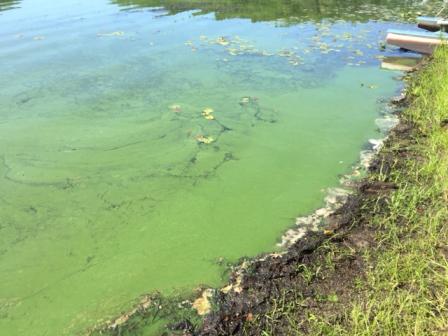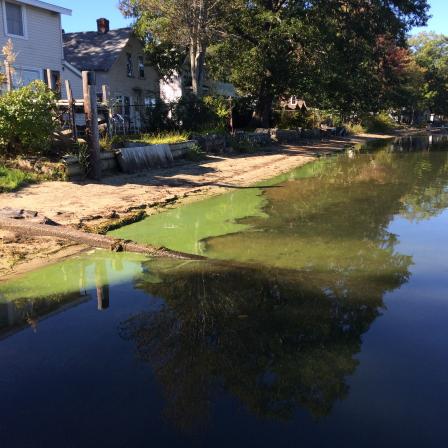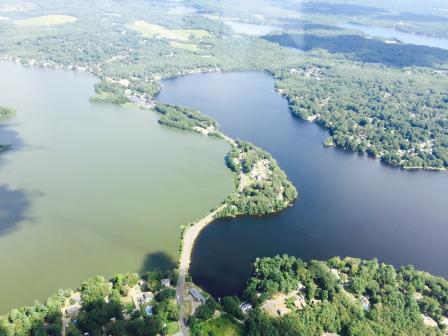Monitoring and Responding to Cyanobacteria and Cyanotoxins in Recreational Waters
This information is intended for recreational waterbody managers, which may include public health officials, lake managers, or other state, local or tribal officials, involved in monitoring water quality and protecting the health of people and animals that use waterbodies within their jurisdiction.
DISCLAIMER: This information does not impose legally binding requirements on EPA, states, tribes, or the public, nor does it confer legal rights. It does not constitute a regulation, nor does it change or substitute for any Clean Water Act provision or EPA regulation. Any mention of trade names, products, or services does not convey and should not be interpreted as conveying official EPA approval, endorsement, or recommendation for use.
Visual Signs of a Cyanobacterial Bloom
 Figure 1: Cyanobacterial Bloom - Sudbury River, MA (Photo by Susan Flint)
Figure 1: Cyanobacterial Bloom - Sudbury River, MA (Photo by Susan Flint)  Figure 2: Cyanobacterial Bloom - Lake Attitash (Photo by Nancy Leland)
Figure 2: Cyanobacterial Bloom - Lake Attitash (Photo by Nancy Leland)  Figure 3: Cyanobacterial Bloom - Monponsett Pond, MA (Photo by Edward Broderick)Visual signs of a bloom include:
Figure 3: Cyanobacterial Bloom - Monponsett Pond, MA (Photo by Edward Broderick)Visual signs of a bloom include:- surface water discoloration (e.g., a green, white, brown, red, or blue tint);
- reduced transparency (e.g., water that looks like pea soup or lets limited light through); and/or
- thick, mat-like accumulations of scum on the shoreline and surface. Cyanobacteria are also associated with unfavorable taste-and-odor compounds in lakes and reservoirs. The photos below of cyanobacterial blooms depict common visual characteristic of blooms.
A cyanobacterial bloom may be present without producing cyanotoxins, and conversely, cyanotoxins can be present both before and after blooms are visible. Therefore, it is recommended that cyanotoxin levels be confirmed through laboratory testing of the water. Microscopic phytoplankton identification can provide information when blooms are present and not visually apparent.
Microscopic phytoplankton identification can provide information when blooms are present and not visually apparent. Although the title is geared to tribal communities, information in it is useful to any recreational water manager looking to identify cyanobacteria.
For more information on phytoplankton identification and images see:
- NOAA's Phytoplankton Monitoring Network (PMN) Freshwater Plankton Image Gallery
- USGS: Field and Laboratory Guide to Freshwater Cyanobacteria Harmful Algal Blooms for Native American and Alaska Native Communities (PDF) (54 pp, 8 MB) -- Although the title is geared to tribal communities, information in it is useful to any recreational water manager looking to identify cyanobacteria.
- CyanoScope Algae Guide to the Section on Visual Signs of a Cyanobacterial Bloom
Developing an Emergency Response Plan for Cyanotoxins
Recreational waterbody managers can take several steps to prepare in the event of a future cyanobacterial bloom. Recreational managers with limited resources may choose to take a risk management approach toward monitoring the recreational water bodies under their jurisdictions. Such an approach may include prioritizing water bodies based on the likelihood of a HABs event and its relative impact to the public. Prioritization may consider past occurrences of HABs, current environmental conditions (including the levels of nitrogen and phosphorus, temperature, availability of organic matter, light attenuation, and pH), and waterbody use (i.e., type of recreation and the number of users).
- identifying state-designated recreational water health advisory levels for analyzing the severity of a bloom (as measured by cyanotoxin concentrations or cyanobacteria cell counts); and
- taking specific actions, such as issuing public advisories, posting warnings, and closing waterways that exceed a predetermined threshold.
Elements of such a plan should include a Monitoring Plan with the steps to confirm a cyanobacterial bloom event and monitor cyanotoxin levels, including when to post and remove notification signs. The Emergency Plan should also include a Control and Treatment Plan listing the actions to be done to reduce nutrient pollution and avoid bloom occurrence, and the control and treatment option(s) available for cyanobacterial blooms and cyanotoxins in the waterbody. In addition, the Emergency Response Plan should include a Communication Plan that includes key contacts and ways to notify the public. The Communication Plan should also include signage and other communication methods to notify the public and the media of a cyanobacterial bloom event.
- Conduct water analysis to determine if the cyanobacterial bloom is producing cyanotoxins at levels potentially harmful to human or animal health.
- Notify key partners at the local and state level, including drinking water operators and managers if the waterbody serves as a source of drinking water, to coordinate a response.
- Issue public notifications (i.e., warnings, advisories, or closures) based on the cyanotoxin level and the risk it presents to human and animal health.
- Consider treatment options, if necessary, to bring cyanotoxins concentrations under control and down to safe levels.
- Monitor and sample the recreational waters to confirm or modify the notification until two consecutive tests show the cyanotoxins concentrations are below safe levels and visual signs of the bloom are gone; notifications can be lifted once cyanotoxin concentrations are below safe levels.
EPA recommends that state water recreation managers or appropriate state partners report suspected or confirmed harmful blooms and/or human and animal illnesses associated with cyanobacterial blooms to the One Health Harmful Algal Bloom System (OHHABS). The Centers for Disease Control and Prevention (CDC) developed OHHABS as a voluntary reporting system available to state and territorial public health departments and their designated environmental health or animal health partners.
For more information on how to develop response plans for cyanobacterial blooms in waterbodies see:
- Recommendations for Cyanobacteria and Cyanotoxin Monitoring in Recreational Waters
- Cyanotoxin Management Plan Template and Example Plans -- although we created this resource to assist water utilities that want to develop their own cyanotoxin management plans, this resource also offer information for managers to assess the conditions of the source water.
- Cyanobacteria Bloom Response Contact List (Word document)(1 pg, 34 K, July 2017, EPA 820-F-17-003) Free Viewers
- Communicating about Cyanobacterial Blooms and Toxins in Recreational Waters
The Global Water Research Coalition issued a guidance manual to help waterbody managers and drinking water treatment plant operators understand the importance of cyanobacteria and the toxins they produce; assess the risks associated with a particular water body; develop a monitoring program; and, implement management procedures at affected water bodies and treatment plants.
- International Guidance Manual for the Management of Toxic Cyanobacteria (Global Water Research Coalition) (PDF) (107 pp, 3 MB) Exit
- NOAA's Phytoplankton Monitoring Network (PMN) Freshwater Plankton Image Gallery
- USGS: Field and Laboratory Guide to Freshwater Cyanobacteria Harmful Algal Blooms for Native American and Alaska Native Communities (PDF) (54 pp, 8 MB) -- Although the title is geared to tribal communities, information in it is useful to any recreational water manager looking to identify cyanobacteria.
